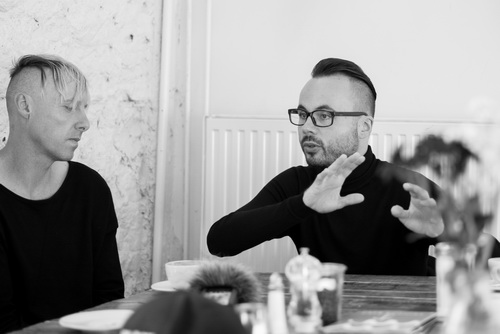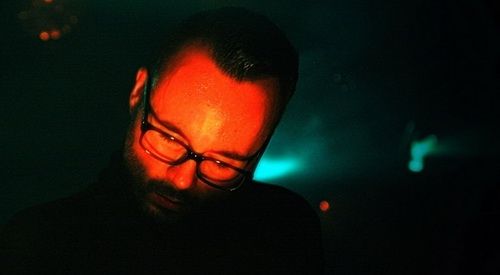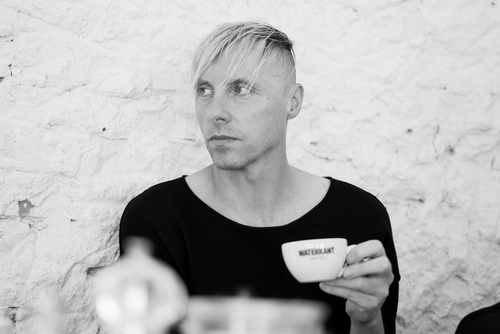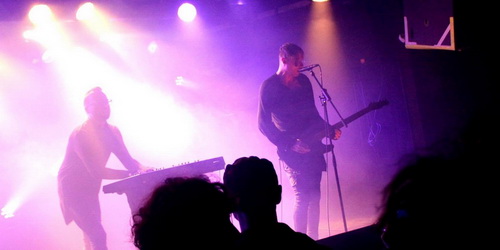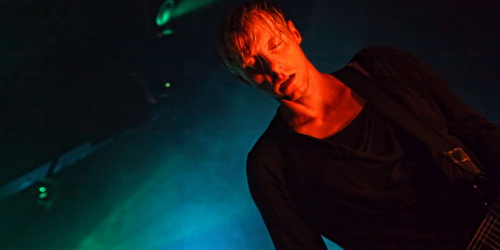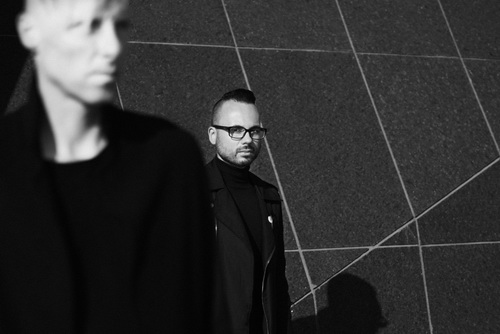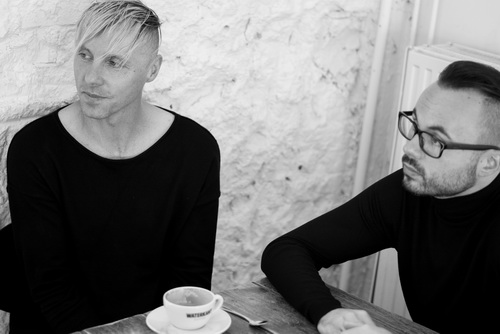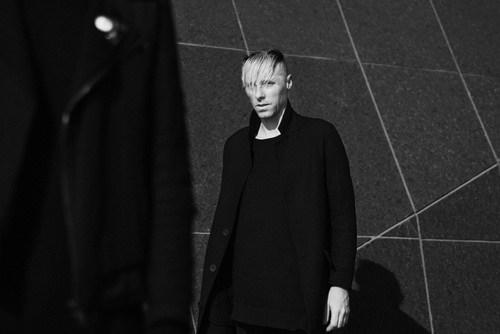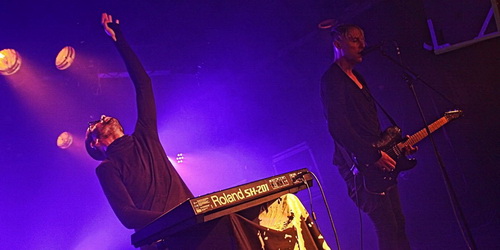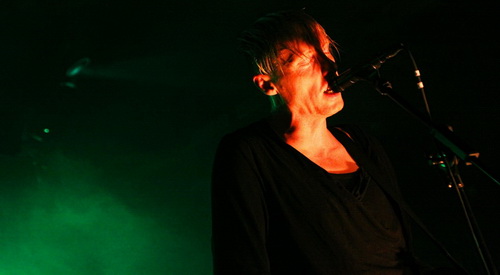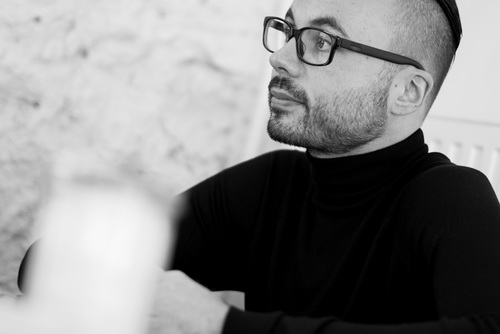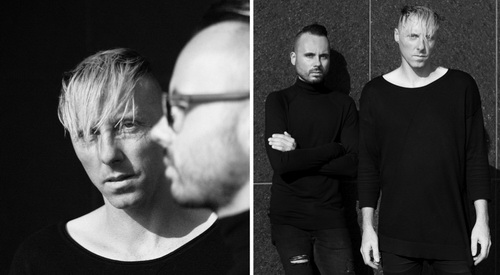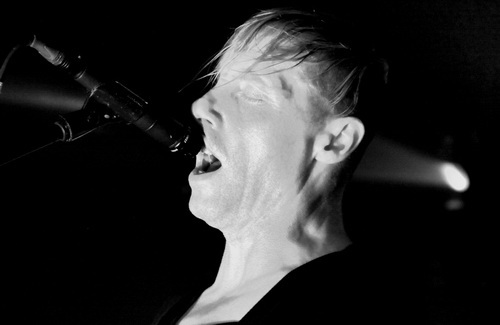
An odyssey of pain, happiness and sadness: TRAITRS interviewed
Posted In Interviews,Slider by Jimi Nilsson
The last few years have seen the arrival of bands such as Actors, Then Comes Silence, The Foreign Resort and The KVB, contributing to a vibrant and exciting new wave of post-punk and coldwave. One of these electrifying new bands that struck a special chord with us is Toronto two-piece TRAITRS, formed in 2015. Sean-Patrick Nolan and Shawn Tucker joined forces with producer Josh Korody and together they created the signature sound of TRAITRS.
In 2016 “Rites and Ritual” was released, 2017 saw the arrival of EP:s “Speak in Tongue” and “Heretic”. And in May 2018 they had a breakthrough on the scene with “Butcher’s Coin”, a record filled with a lot of emotions and, above all, it was an album showcasing great song-writing skills.
In February and March, they will tour the Nordic countries. Release sat down with Sean and Shawn when they visited Hamburg to chat about writing “Butcher’s Coin”, their interest in horror and occult aesthetics, the difference between Toronto and Europe and being overwhelmed by the reception of the European audience. After a horrifying coffee incident and much fascination about how much coffee an ordinary mop can hold, we started off the interview and photo session.
“We just do everything through feel and instinctual”
We’re in the middle of a post-punk revival. Although you, as many bands of this new post-punk era, have influences of the original eighties post-punk wave, it stands mostly on its own when you listen to the modern post-punk sound. How would you say that post-punk today is something different from the eighties sound of the scene? Or is it the same?
Sean: For us, when we’re writing and when we’re in the studio it’s both things. We obviously listen to those older bands and trying to figure out why their songs sound a different way and what makes them sound that way, but at the same time it’s really important that we have our own identity.
It’s not enough just to be a revival band, it’s more important for us to develop our own sound and our identity, and that’s where we bring in different elements, not just from post-punk music as Joy Division and Bauhaus.
Shawn: I do hear what those bands are doing in comparison to what the bands are doing now and there is quite a difference. I’m always like ”Oh it’s the era, it’s the feel, it’s the economy, it’s the politics surrounding this” but it also came down to the recordings and that icy cold reverb snares, and the atmosphere as well. With some of the new post-punk it’s hard to bring back that sound because of how far we’ve moved in technology and recording. Today, the recordings are richer, they’re warmer and they’re louder.
Sean thinks current post-punk bands have the benefit of hindsight.
- They can listen to all the old stuff and really pick it apart and try to find things, just like the Opposition which is a great example of a band that not everybody has heard of. You can really hear that they write great songs. And you can pick out interesting ideas that you know aside from just listening to Joy Division all the time. There’s all these other small bands, as Asylum Party, a great coldwave band. Early on for us we were listening to them a lot just to try to get “newer old ideas”.
Shawn: That’s right, you collect newer old ideas and kind of bring them to life. For TRAITRS, we’ve approached things a little bit differently than most bands. We kind of only wanted to write strictly from feel and emotion and I felt that all those bands back in the day had so much of that; it was in the melodies, it’s in the passion, it’s in the drive, it’s in the motivation. And if you’re going to do that you’ve got to bring the heart in it, that’s a huge part of it.
If you can bring in that aspect and tap in to it, it’s always the same. We can put on “Meat Is Murder” and be like “OK, the world is going to stop today” and think how this still isn’t the biggest album ever. It still touches people just like it did 30 years ago and for us it’s something to strive for. The aim for TRAITRS is to connect emotionally with the audience.
Sean: It’s something that we’re always reaching for,. It’s not enough that they just go “Oh, this kind of sounds like post-punk”. No, we want you to feel something when you hear us and we’re always aiming for that.
Shawn: It always keeps you thinking and evolving; we’re always talking about textures in music.
Sean: And those old bands had that. We’ve been listening to a lot of old bands lately, like the first two Tears For Fears albums, and just listen to the sound of their voices. It’s like there’s a lifetime of hurt and pain and happiness and sadness – and that’s just in their voices. What we’re trying to do is to reach those same benchmarks in 2018.
Shawn: I also think a lot of bands in 2018 who are doing the post-punk revival are going for a classic sound. We always try and put a little bit of a spin on it because we’re a post-punk band but we’re also kind of a coldwave band.
Sean: And we try to bring a lot more modular synths in the studio and just add layers and stuff.
It’s kind of fun because most post-punk bands I’ve interviewed lately say they are coldwave bands that sounds a bit post punk.
Sean: That’s right, but if you listen to Joy Division live, or even Warsaw live, they are a punk band, they sound like a punk band. It was when working with Martin Hannett they really brought out this sort of other-worldly element to their music.
The evolution of sound
And that brings us to your latest album. I really have to say that “Butcher’s Coin” went straight into my Top 10list this year, just beaten by IAMX, and since your debut “Rites and Rituals” you have evolved a lot in terms of the TRAITRS sound. How would you describe this development and the turn your music took?
Shawn: Damn you Chris Corner (laughs)! But I will forgive him, he’s all OK.
Early on I was obsessed with Southern Death Cult. Well, I still am, and we were trying to bring in more tribalesque post-punk elements and keep it very, very raw. And at the same time it was so early on and we were just kind of developing who we were, and it did take a very drastic shift.
Although we’re kind of happy with how “Rites and Rituals” did, and it definitely set who we are, we still felt like there was so much more, and that’s where that change came in.
Sean: We did the same even with “Butcher’s Coin”; in hindsight I feel like there’s still so many opportunities that we missed out on and things that we didn’t accomplish that we talked about doing at the beginning of the recording process, but we definitely wanted to enhance the production.
And the song-writing of “Butcher’s Coin” is a lot better, well not necessarily better but maybe more matured and more developed, and that’s just an instance of us working together longer and learning how to put this whole thing together.
There’s a real rawness to “Rites and Rituals”, and it was intentional. We had no idea, we had no fanbase, we had no record label, we had nobody that knew who we were at all, and we just wanted to reach out.
Shawn recalls the song that started it all.
- The first thing we wrote was “Witch Trials”, and it was just us in my flat, and we were just sitting there trying to figure out what we wanted to do. We knew the bands we love, we knew the sound that we wanted and we had just been writing for so long, but it wasn’t until we hit “Witch Trials” that it kind of gave us a little bit of an identity of where we were going to go at the time. And from there it just kept growing.
Sean: When we put out the cassette it was almost just to cast a wide net and see who would enjoy it or like it, or if anybody liked it. We were willing to accept if nobody liked us, just like “Fine, then we’ll go back to the drawing board”.
But when we did that, people from Germany, Italy, Chile, Argentina and Mexico started picking up on the cassette and it gave us that sort of extra confidence to go “Oh, there is an audience for this stuff that we might not know of in Toronto”. With that confidence we could go forward and tour and then write “Butcher’s Coin”, with that in the back of our mind that there is a hunger for this kind of music.
Shawn: But I also think we did take a bit of a chance, knowing that it was a change. Not so much a directional one but there was an overall change. For a really new artist to change and go “You know what, we just do everything through feel and instinctual”, and if we feel that “Hey, we’re loving this, we want to back this and this is our identity”, they will see it too.
Sean: We did that with “The Lovely Wounded”, which is the song that comes in the middle of the album.
Shawn: That was the last one to go on the album because for some people this is too much, but we just trusted the instinct on this one. “The Lovely Wounded” is a pretty good example of the change we talk about, it shows that we are not one dimensional.
Sean: And that’s why we put it the middle of the album. It’s almost like an intermission break between the first and second half, that was very intentional, and something that we want to continue doing and develop in the future. Not becoming an electronic band but how we use electronics with the sort of framework that we’ve built up and to continue to find new atmospheres and textures.
And it is a song that people really attach to. A lot of times when we talk to people in the audience after the shows they will say “Oh, we love you guys, there’s something about ‘The Lovely Wounded’, it’s something about that song that we can really kind of attach to emotionally”, and for us that’s really important.
Embracing the horror aesthetic
For some bands the entire set of visual symbolism they surround themselves with – band photos, artwork, stage shows etc – are as integral to the entire concept of the band as the music, at the very least adding something to the entire music experience. And TRAITRS find their representations in the occult and the horror movie aesthetics.
I know that you’ve always been drawn to darker music, horror films and occult themes, and that aesthetic comes back in the song titles on your debut, on the new album and in your lyrics. I guess that “Omen” refers to the film for instance. What other references do you have on the album and in the artwork?
Shawn: That’s right and on the first album “Heretic” is from the The Exorcist 2.
Sean: On the album it’s maybe more lyrically than the titles. There are references, not necessarily to horror movies but just like in “I Sit and Watch the Worm Beneath My Nail”, that is from a Dylan Thomas poem, the old Welsh poet.
The way that I kind of feel that references should be in lyrics than in songs and titles is that it should be able to stand on its own whether or not you understand the reference. If you do get it, it’s like an Easter egg: “Oh, I know where that’s from” but if you don’t, the lyric should still work and it should still resonate with people that don’t necessarily know that “Burnt Offerings” is an old horror movie. But I have to admit it’s kind of fun to put those things in.
Shawn: It is and in, let’s say, the “Hand of Holy Fingers”, we were in between “Rites and Rituals” and “Butcher’s Coin”. That track is about a woman who lost her mind and who believes in the church and believes in a greater power but with her illness it makes her sick, and by making her sick she drowns all her children for god.
But that’s just how I write; I write from hurt or things that intrigue me and needs to be further explored. Like on “The Lovely Wounded”; it’s also about losing everything that you want. I mean, we’re not here for very long and just losing that one thing that made you whole your entire life, and what you have left after that, is nothing but painful. That’s really the premise.
When I mix it with this horror element it really comes together more easily for me. I can also do a lot of really weird and interesting play-on-words things or on things that only I know, but that’s how I connect to it a lot easier.
From “Rites and Rituals” to “Butcher’s Coin” I kind of shifted out a bit. “Rites and Rituals” has some kind of mid-century feel to it too and I just kind of was shaking that out a little bit, and now it has become what it is (laughs).
Since you chose the aesthetic with much thought you probably work much with your artworks and art in general as well. Most bands leave it to someone else to decide but you seem to put much effort into doing something special. How do you work with artworks, sleeves and booklets for your albums and EP:s?
Shawn: I’m going and sorting through it and sort again; it’s only when I see it and what I can do with that I can bring it to life.
What is interesting is that “Butcher’s Coin” originally was supposed to be almost like a concept album of this house that had generations and decades of different families living in it and horrible things happening to these families. I wanted to do this kind of piece but when we had come roughly half-way through the writing it kind of switched for me, and that’s why the back of the album is something I constructed from scraps.
I took this photo of an old house that I liked and wanted that type of scruffy background, and layers on it. The most cursed artwork is in the window with the children. There’s a serial killer that has killed children for years, standing in the grass; I brought in a lot of these elements in it (laughs). But sometimes I really don’t want to take too much from the film itself, we’ve already seen that for thirty years.
You don’t feel like you play with coldwave/post-punk stereotypes and the dark and depressive themes that you kind of associate many bands with?
Shawn: That’s so funny because that’s just everything we aren’t (laughs).
Sean: We’re really conscious of not being over the top, or at least trying not to be. It sounds like “Oh, it’s very dark and menacing music” but we’re just trying to not make it cheesy or campy, like talking about vampires and blood and skulls and stuff, and do it in a bit more of a nuanced way.
Shawn: Let’s take the cover of “Butcher’s Coin”. I felt like that was a bit of a departure for us and we’re trying to say “Hey, this is who we are, this is our identity, post-punk really needs to be dark” but that’s not really what we are (laughs). But we play around with those elements. It’s more about hurt and struggle and loss and fear. I can tap in some anger elements in there at times and a lot of frustration (laughs).
Sean: But that also comes from personal life too. Toronto is a really expensive city to live in, it’s very hard to live day to day and trying to be an artist in the city, it’s next to impossible. Politically that’s happening all over the world because there’s a lot of uncertainty going on across the entire planet right now. It’s not a very happy world to be in right now.
Shawn: It’s turning into Reagan times again when punk bands and that whole movement came up and now it’s like “Here we go again”.
Overwhelming reception in Europe
In 2015 Nick Smash documented Toronto’s post-punk scene in his book “Alone and Gone – The Story of Toronto’s Post Punk Underground”, from its early days of truly cutting-edge music following the implosion of first-wave punk to its eventual dilution and adoption as mass-marketed new wave.
However, as the title suggests the post-punk scene wasn’t particularly long-lived and never reached the heights of its predecessor, the punk scene, a scene still contributing to a vibrant underground culture in the city. And when you consider an overall music scene known for bands as Rush, Drake, Feist and Deadmau5 it might feel like going against the tide to be a post-punk band in Toronto in the 2010:s. But there might be a solution in a (temporary) move across the Atlantic.
I’ve been to Canada more than a few times and I don’t really associate the Toronto scene with post-punk or coldwave. Or is there a vibrant scene?
Sean: Right now I would say no and the thing is that the scene is getting smaller and smaller. In the late nineties and early 2000:s there were a lot of alternative clubs and a lot of live bars, but over the last couple of decades they got shutdown or pushed out. There is a scene and there is an audience for post-punk music in Toronto, but it’s difficult to get attention or to get enough people to come out.
Shawn: What’s interesting though is that when post-punk and coldwave bands were happening earlier on, in the late eighties or even the early eighties, there was a very big scene in Canada and Toronto.
I feel that it has obviously diminished but I still believe that in people’s hearts somewhere, they still go “Oh, I love The Cure and I love those early bands”. There is a potential for it to grow and I do believe that there is a hint of a resurgence in Canada and especially in the US.
You did the first leg of the tour in May and July when you played a few festivals and now you do the second leg, and musically you must fit better on the European scene than in Canada. How different is it to play in Europe in general and Germany in particular in terms of support and fan feedback?
Sean: It’s a lot more welcoming I would say and people seem more willing to take a chance on bands they’ve never heard of before.
We came over here as a relatively unknown band aside from some small press, but they seem more open to take a chance on a band that they’ve just checked out a week or two before. In Toronto Radiohead will draw people and Interpol will draw people but it’s really difficult for young bands outside of a small underground scene of people to draw people’s attention that they actually come and listen to new music. Toronto has a reputation for its kind of cold, arms-crossed like crowds.
Shawn: But it really depends on the movement; if you’re on a punk show the crowd is very much into the music. But on a scene not punk or something major mainstream it can be a bit colder. You can perform and you won’t know if anybody is enjoying it until after the show, but here you feel it before the show, during the show and you always feel it after that they’re very appreciative.
I can be like “Thank you so much for showing up” and they’re like “No no no no no! You’re here, thank you!”; that’s a really big difference! They want to talk, they want your pic, they want all your stuff (laughs) and they buy stuff.
Sean: And they want autographs, and they want to take photos with us (laughs). At this stage we’re a really young band and have only been doing this for almost three years now, and for us that was really something to get adjusted to, like people wanting signed setlists and wanting us to sign records, because back home we’ve never done that.
I guess that playing Wave Gotik Treffen then must have been something special, and Castle Party as well?
Sean: Yes, WGT was amazing! We were on a really good night, played on a Saturday night, and the venue was totally full. We had friends that wanted to come in but had to turn at the door because we were already at full capacity. It was just really crazy for us to come from so far and to feel that welcomed and to play at such a packed venue – an awesome experience!
And then Castle Party; we didn’t know what to expect. We were on at four in the afternoon and were the first band on Sunday night, and all the after show parties end at eight or nine in the morning, and we thought we were going to walk onto that huge stage and play to ten hungover people that probably slept in the park from the night before.
But when we walked out it was full! People kept coming out and we got asked for an encore, it was really overwhelming! We didn’t know what to expect as a Canadian band playing a Polish gothic music festival on Sunday at four in the afternoon, it completely blew our expectations away totally.
Have you considered to focus more on Europe and Germany in the future and let go of North America? Your label, Pleasence, is Toronto based but you have European labels and distributors in Poland, France and Spain.
Sean: They put out the “Heretic” EP, pieces from the first cassette that we put out. But it’s definitely something that we’re talking about with our families back home, about relocating at least as a temporary thing.
Shawn: It’s kind of a no brainer at this point. I think if we don’t do it, it’s kind of like you dip your toes in and then you miss out on the opportunity (laughs).
Sean: And the growth has been amazing, even from just comparing this tour and the summer tour to our very first one; on every show there’s more people, and there’s people finding out about us online and seeking us out.
We played Sziget in Hungary just outside of Budapest, a Monday night, and the place was completely full. That was a show where we were like “I don’t know, we’ll see who shows up” and every show has been like that, especially on this tour. In Görlitz, it was the same thing.
Shawn: We just had it happen in Munich as well. We played Munich, it was our first time, and the promoter said “You know, I usually recognise all the faces until I booked you guys and then all of a sudden, wow! There‘s loads of new people I’ve never seen”, and she said “You’re drawing crowds from wherever and I don’t know“. It’s growing very fast for us.
New recordings
I know you are very productive, does it meant that you’re going back to record new stuff already or is it time for a break?
Sean: We like to stay busy and don’t want to feel any kind of stagnancy – and we have been writing a lot. We brought all our equipment with us so we can write in the bedroom or in the hotel or wherever we stay.
Shawn: We’ve been writing like crazy, already on this tour, and are ready to gear up to record when we’re home again. During winter we write everything and stay inside to record. I’m always writing and always thinking about the next thing.
Sean: We have ideas from a month or two before we left for this tour that we brought with us. It’s just something being really close in a room together and being in another part of the world writing, and we can draw inspiration from it.
And like I was saying, taking some of the elements of “Butcher’s Coin” that we missed out on or didn’t explore totally.
We’re very self-aware of where we missed out or where we didn’t fully explore an idea and always want to make sure we don’t make that mistake, maybe not necessarily a mistake, but grow on that and learn from things we’ve done in the past.
That means a new album quite soon then?
Sean: For sure but I’m not sure exactly because we’re doing the Scandinavian tour at the end of February and the beginning of March with Then Comes Silence and The Foreign Resort. And we have to see when we get home from this tour.
Shawn: I do know that they [the label] are pushing for us to do something, like an EP. But we will obviously come back next year and would like to come back with a full album, but the timing got to be right.
Sean: But we feel that we creatively are on a roll at the moment so it’s really important to continue pushing forward with that.
You need to release something soon just to remind fans about you?
Sean: Exactly and especially now. We’re not in a position, let’ say like Interpol, to go away for five years – and that’s good for them to go away for five years – and then they could come back and it’s like “Oh, Interpol is back”. We have to keep knocking on the door.
Shawn: But The Cure did that as well, released an album every year in the beginning, so I believe it’s going to be the same for us (laughs).
Sean: With the short attention spans of people now you need to do that, we need to go like “Hey, remember us, we’re here and don’t forget us”.
But you still believe in the album format? Because quite many bands say it’s dead and release singles instead.
Shawn: That would never interest me, not at all.
Sean: There aren’t really any singles anymore and I think it’s too hard to measure – if you’re not Rihanna or Justin Bieber – what is a successful single? “Thin Flesh” has been for us a really successful single but it doesn’t has the same plays as these other artists, but it’s something that really captured the attention of people. But we don’t write with that in mind.
With “Butcher’s Coin” we really liked the idea of approaching it the way bands in the past did. Musically it definitely tells a story and it has peaks and dips, and that was something we looked at with great excitement.
That’s very interesting because for many bands back in the eighties the order of the songs was important for the narrative of the album but today hardly no one talks about that anymore.
Shawn: That’s why there’s a part of me that want to release a full album. Yes, I want to go back home and release like a three or four-song EP but from my heart I just want to do another full album because in order to go where I want to go I need the time to give you nine or ten songs to take you where we did with “Butcher’s Coin”.
Sean: We have to see because now it’s all about timing and when we’re back home we’ll talk to our home record label and see what they think is best, but if it was up to us we would every year put out another ten to twelve songs
Shawn: Right now for us to go home and record an EP and then having to record a full-length as well by next year – the EP would probably be dropped early spring and then we need another full-length for the fall – it’s a lot of work.
We’re so busy already and that’s just an enormous amount for us to take on but we’ll probably do it (laughs). But I really want to have the right amount of time, that’s what we had with “Butcher’s Coin”.
I’m very, very strict with myself with everything and it just takes time to know that it’s finished and I’m OK giving it to you. No teasers before it’s done, not if I can decide (laughs).
Live photos for Release by: Jolanda van Velzen
Interview photos for Release by: Teresa Enhiak Nanni


